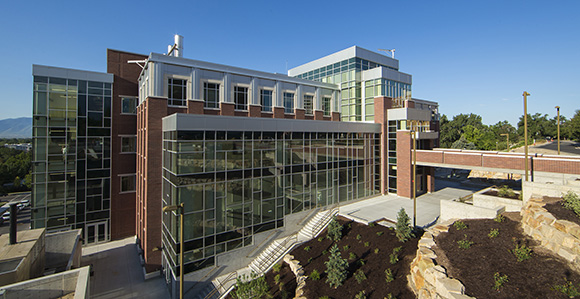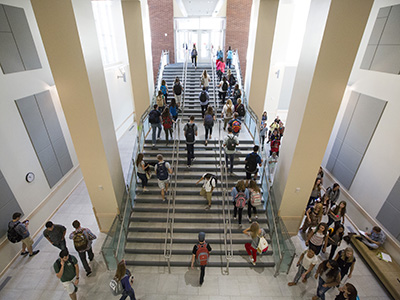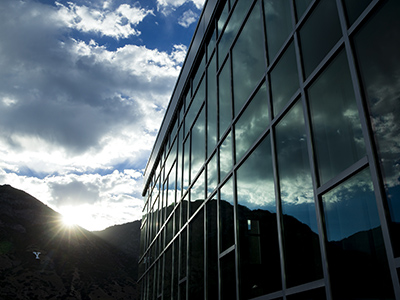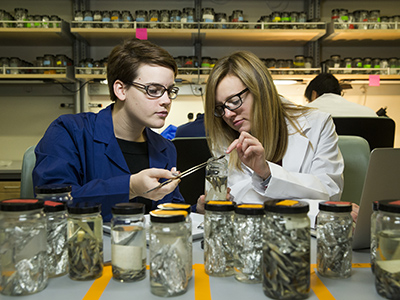New Life Sciences Building Opens at BYU
Contributed By Marianne Holman Prescott, Church News staff writer

A photo of the exterior of the new Life Sciences Building on the south side of the Brigham Young University campus. Photo by Jaren Wilkey/BYU.
Article Highlights
- The building stands as a “gateway” to the south end of campus.
- It features 24 teaching labs, three auditoriums, four conference rooms, and 70 academic offices.
- The 265,000-square-foot building opened for the fall semester.
“This building moves us right to the edge of the future.” —Rodney J. Brown, dean of the College of Life Sciences at BYU
PROVO, UTAH
After nearly three years of construction, a new “gateway” for the south end of the Brigham Young University campus greeted students and faculty beginning the fall 2014 semester. The building—home to the Life Sciences Department—is located on the hillside near the well-known duck pond and has more than 200,000 square feet dedicated to teaching and research.
“This is a building you like to spend time in; you want to be here,” said Rodney J. Brown, dean of the College of Life Sciences at BYU. “The new building is a lot better designed for student-faculty interaction, making it possible for mentoring and doing research together.”
Announcement of the new building came in November of 2011. After only a little over two and a half years of construction, the five-level, 265,000-square-foot building was ready for school to start.
The new building houses 24 teaching labs, three auditoriums, four conference rooms, and more than 70 academic offices. The building is student friendly, with common areas for the students to meet, study, and learn. The building is home to the Life Sciences Departments, including biology; microbiology and molecular biology; physiology and developmental biology; exercise science, nutrition, dietetics, and food; and plant and wildlife science.
The entire second floor is being called the “student” floor because of the common areas and resources available there. Labs, conference rooms, couches, tables, vending machines, computer labs, and even the advisement center are all on that floor. Three large anatomy labs are housed on the second floor, and a biology 100 (a general education class taken by most BYU students) help center and other areas are available for students to meet with other students to study, as well as their teaching assistants.
“It is a lot better designed for student-faculty interaction,” Brother Brown said. Faculty and students are able to join efforts in doing research, making the building a great resource in mentoring students.

Students walk through the Life Sciences Building on the first day of classes of BYU's fall 2014 semester. Photo by Jaren Wilkey/BYU.

When asked, most people said they liked the windows in the building best. Photo by Jaren Wilkey/BYU.

Alex Acer, left, a biology undergraduate student, and Kandace Hugentobler, biology master's graduate student, work together in a research lab in the new Life Sciences Building on the BYU campus. Photo by Jaren Wilkey/BYU.
Although the hi-tech capacities built in each classroom and lab and new parking garage are nice, Brother Brown said “when I ask people what they like best about the building most of them say they like the windows.”
Prior to the new building most of the labs and classes were in the Widtsoe and Cluff buildings on campus.
“We had teaching labs and research labs and were doing things in the two floors underground,” said Brother Brown. “We didn’t have any space for students in between classes or any large student spaces. The new building is full of students studying and working together. It is a whole different atmosphere.”
In an effort to coordinate with the Life Science instruction and research housed in the building, the architect’s plan was designed to look like a large reddish mountain with a river running down the middle of it. If you walk through the building today, the red brick building gets smaller as you ascend to the top and has a staircase running through the middle of the building.
Plants and large trees line the walls of the hallways and include a plaque with the name of the plant and a bar code that, when scanned by a smartphone, pulls up more information about that variety. Windows all along the top of the corridor make the building light.
“It is bright,” said Brother Brown. “There is light shining in everywhere in the building.”
But that light in the new building reaches far beyond the windows and hallways. Brother Brown looks at the new building as a “temple of learning.”
“This building moves us right to the edge of the future” he said. It is a place for students to study and find, as it says in the scriptures, “ask now the beasts and they shall teach thee, and the fowls of the air and they shall teach thee.”
“The things that are being discovered in the Life Sciences are clearly in that group. … As important as how a plant works and grows is, you put that together with the gospel and you have a terrific foundation for life and for making a living too.”
